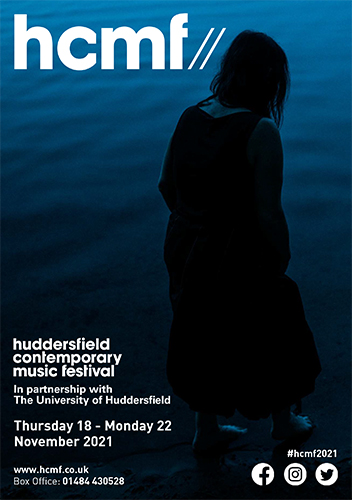 Though this year it only lasted five days instead of ten, i came away from the 2021 Huddersfield Contemporary Music Festival with the distinct impression that, somehow, the usual quantity of music had been compressed into a reduced time frame. That’s not, mercifully, because of any attempt to shoehorn many more concerts into each day; to be honest, i think it’s partly a consequence of the process of getting used to concert-going again. Even though concert life is increasingly back to normal here in the UK, five consecutive days packed full of music still felt more than usually like an overwhelming glut. i’m sure that this impression was reinforced by the very wide stylistic diversity of music that we heard, which has become a hallmark of Graham McKenzie’s tenure as Artistic Director of the festival. It occurred to me just before setting off for Huddersfield that this was the 25th anniversary of my first experience of HCMF (in 1996); it was a blazing start to a passionate love affair that quickly cooled as the festival became increasingly tame, narrow and predictable in the years following Richard Steinitz’ departure. For quite a few years i ignored HCMF completely, and it wasn’t until the late 2000s that it caught my attention again, and perhaps the most important factor in maintaining my interest and enthusiasm since then has been the consistent range of its diversity and unpredictability.
Though this year it only lasted five days instead of ten, i came away from the 2021 Huddersfield Contemporary Music Festival with the distinct impression that, somehow, the usual quantity of music had been compressed into a reduced time frame. That’s not, mercifully, because of any attempt to shoehorn many more concerts into each day; to be honest, i think it’s partly a consequence of the process of getting used to concert-going again. Even though concert life is increasingly back to normal here in the UK, five consecutive days packed full of music still felt more than usually like an overwhelming glut. i’m sure that this impression was reinforced by the very wide stylistic diversity of music that we heard, which has become a hallmark of Graham McKenzie’s tenure as Artistic Director of the festival. It occurred to me just before setting off for Huddersfield that this was the 25th anniversary of my first experience of HCMF (in 1996); it was a blazing start to a passionate love affair that quickly cooled as the festival became increasingly tame, narrow and predictable in the years following Richard Steinitz’ departure. For quite a few years i ignored HCMF completely, and it wasn’t until the late 2000s that it caught my attention again, and perhaps the most important factor in maintaining my interest and enthusiasm since then has been the consistent range of its diversity and unpredictability.
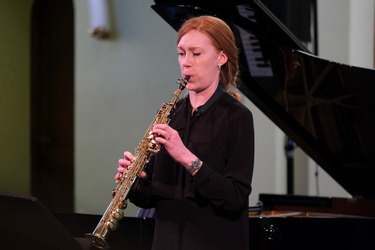 Apropos: three of the standout works from the festival’s annual “Shorts” day (the most polarising day of the festival, when it’s as if the lunatics have temporarily been allowed to run the asylum) were by composers i hadn’t encountered before. Anna Appleby‘s 5-minute solo saxophone piece 13.8 Billion Years began as a soaring melody, before exploding into florid life peppered with key-clicks (which, for once, didn’t seem like an overused effect) and sharp multiphonic colourations. Amy Green’s performance of the piece was fantastic: beautifully controlled through the opening, and genuinely mesmerising as the work developed, coming across like a snake charmer. Though both the title and the premise of the piece were (deliberately?) preposterous, it didn’t matter; i interpreted it that the previous 13.8 billion years had all been leading up to this particular moment – a wait that felt totally worth it.
Apropos: three of the standout works from the festival’s annual “Shorts” day (the most polarising day of the festival, when it’s as if the lunatics have temporarily been allowed to run the asylum) were by composers i hadn’t encountered before. Anna Appleby‘s 5-minute solo saxophone piece 13.8 Billion Years began as a soaring melody, before exploding into florid life peppered with key-clicks (which, for once, didn’t seem like an overused effect) and sharp multiphonic colourations. Amy Green’s performance of the piece was fantastic: beautifully controlled through the opening, and genuinely mesmerising as the work developed, coming across like a snake charmer. Though both the title and the premise of the piece were (deliberately?) preposterous, it didn’t matter; i interpreted it that the previous 13.8 billion years had all been leading up to this particular moment – a wait that felt totally worth it.
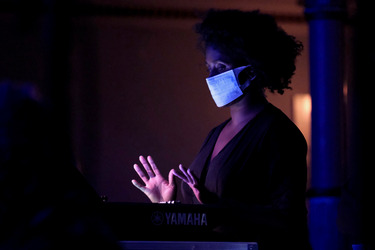 Solve et Coagula, a new electronic work by Nigerian-born Nwando Ebizie, took the form of an atmospheric, quasi-ambient shifting surface of strings incorporating a variety of horn-like calls, deep bass and buzzing tones. Ebizie’s control of these elements was lovely, conveying a strong dramatic sense, organically moving through complex polarities of density and drone, often in unexpected directions, though its caprice was balanced by a measured approach to articulation, always keeping the drama subtle. Seriously beautiful stuff from an artist i now want to explore a whole lot more.
Solve et Coagula, a new electronic work by Nigerian-born Nwando Ebizie, took the form of an atmospheric, quasi-ambient shifting surface of strings incorporating a variety of horn-like calls, deep bass and buzzing tones. Ebizie’s control of these elements was lovely, conveying a strong dramatic sense, organically moving through complex polarities of density and drone, often in unexpected directions, though its caprice was balanced by a measured approach to articulation, always keeping the drama subtle. Seriously beautiful stuff from an artist i now want to explore a whole lot more.
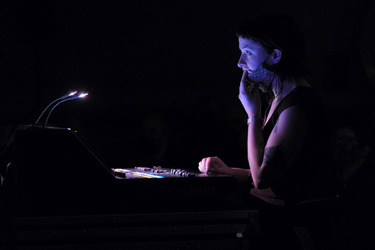 One of the most superb things i heard at HCMF 2021 was Lottie Sadd‘s I’m made up of more space than I actually take up, also receiving its world première. Emerging seamlessly from what appeared to be random snuffles in the audience, we were quickly transported into the bowels – both figuratively and kind of literally – of the human body, exploring a deliciously vivid world of bubble, squeak, gurgle and squelch accompanied from time to time by disconcerting moans and squeals. Bringing to mind the internal mic-based body music of Lars von Trier’s Antichrist, what was perhaps most impressive about the piece was, after a fairly demonstrative start, the way Sadd allowed everything to remain quiet and sparse, as if the sounds were occurring randomly in real time. i’m sure we all left the Town Hall feeling a lot more self conscious about our bodies than we went in; a brilliant piece i can’t wait to hear again (headphone listening would be amazing).
One of the most superb things i heard at HCMF 2021 was Lottie Sadd‘s I’m made up of more space than I actually take up, also receiving its world première. Emerging seamlessly from what appeared to be random snuffles in the audience, we were quickly transported into the bowels – both figuratively and kind of literally – of the human body, exploring a deliciously vivid world of bubble, squeak, gurgle and squelch accompanied from time to time by disconcerting moans and squeals. Bringing to mind the internal mic-based body music of Lars von Trier’s Antichrist, what was perhaps most impressive about the piece was, after a fairly demonstrative start, the way Sadd allowed everything to remain quiet and sparse, as if the sounds were occurring randomly in real time. i’m sure we all left the Town Hall feeling a lot more self conscious about our bodies than we went in; a brilliant piece i can’t wait to hear again (headphone listening would be amazing).
The rest of “Shorts” day was the usual mixed bag of gleaming nuggets of gold and steaming piles of crap, though this year the good stuff far outweighed the bad. Heather Roche’s performance provided an interesting glimpse into a meta-clarinet universe, as part of Scott McLaughlin‘s intriguing project The Garden of Forking Paths, which approaches the instrument from the perspective of its myriad fingering possibilities. As it turned out, McLaughlin’s own piece Fringing was rather dull, almost sounding like a sketch or work-in-progress in its noodling around little oscillating patterns of varying clarity. Larry Goves‘ Borneo Rivers 2, on the other hand, was excellent, perfectly positioned before McLaughlin’s piece and thereby serving as a gradual journey away from the world of familiar and comfortable sounds, venturing into ever more distant and strange regions of the instrument.
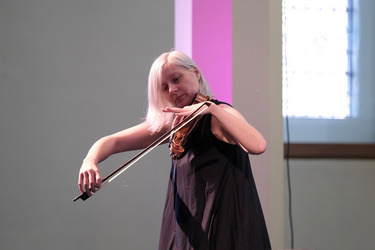 Serbian violinist Dejana Sekulic took a similarly unorthodox approach to her instrument in Dario Buccino‘s Finalmente il tempo è intero nº 16. Taking its starting point from an invitation to the performer to “play incorrectly”, Sekulic’s response was an enthralling, über-tactile spasmodic wrestling with the violin, in which it often wasn’t clear whether she was striving to execute something specific or simply exploring the instrument on a series of whims. On a couple of occasions Sekulic seemed to find a strange kind of solace in soft moaning notes emerging from bowing on the tailpiece, a stark contrast to the wild spluttering and splintering noises from occasions when she practically fought with the instrument.
Serbian violinist Dejana Sekulic took a similarly unorthodox approach to her instrument in Dario Buccino‘s Finalmente il tempo è intero nº 16. Taking its starting point from an invitation to the performer to “play incorrectly”, Sekulic’s response was an enthralling, über-tactile spasmodic wrestling with the violin, in which it often wasn’t clear whether she was striving to execute something specific or simply exploring the instrument on a series of whims. On a couple of occasions Sekulic seemed to find a strange kind of solace in soft moaning notes emerging from bowing on the tailpiece, a stark contrast to the wild spluttering and splintering noises from occasions when she practically fought with the instrument.
 Irine Røsnes demonstrated an altogether more elegant and harmonious relationship with her violin in Simon Emmerson‘s 2010 electroacoustic piece Stringscape. Røsnes pretty much danced her way through what sounded like a singing folk-ritual within a whirling electronic atmosphere that appeared to be emanating directly from the violin, its sounds stretched out and repeated into a dense sonic fabric. She superbly articulated the beautiful mix of simplicity and complexity in Emmerson’s unstoppable song, increasingly identifying as the work’s constant element, while the electronic texture kept changing its behavioural and harmonic makeup around her.
Irine Røsnes demonstrated an altogether more elegant and harmonious relationship with her violin in Simon Emmerson‘s 2010 electroacoustic piece Stringscape. Røsnes pretty much danced her way through what sounded like a singing folk-ritual within a whirling electronic atmosphere that appeared to be emanating directly from the violin, its sounds stretched out and repeated into a dense sonic fabric. She superbly articulated the beautiful mix of simplicity and complexity in Emmerson’s unstoppable song, increasingly identifying as the work’s constant element, while the electronic texture kept changing its behavioural and harmonic makeup around her.

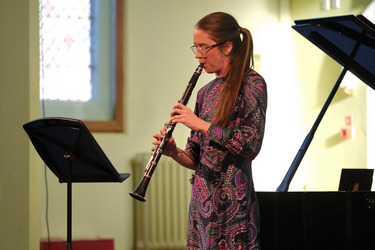
As I think I said in an email to you after Shorts day, I’d spent a lot of it reflecting that, throughout my (admittedly somewhat limited) exposure to the festival’s pieces this year, I was relieved not to have encountered much that was truly awful, but simultaneously underwhelmed by the majority of what I’d heard.
Two pieces blew that “meh” feeling out of the water, and made me view all the others in a less favourable light by comparison. One was the Ebizie, which suited the Town Hall interior so magically well that one almost imagined it had conceived as one of those site-specific “for x forces and concert hall”-type works. But even that was eclipsed by the Matthew Grouse, one of the most shattering evocations of a mind unravelling almost in real time (right down to that presumably deliberately ridiculous costume-change!) that I’ve ever experienced. Feel free to disagree!
But then again, Shorts 2 really was a concert of “gleaming nuggets of gold and steaming piles of crap” contrasts, wasn’t it? In particular, ZK’s seemingly still-shaky quality control when it comes to choice of what to play definitely placed most of his performance in the latter category, for my money.